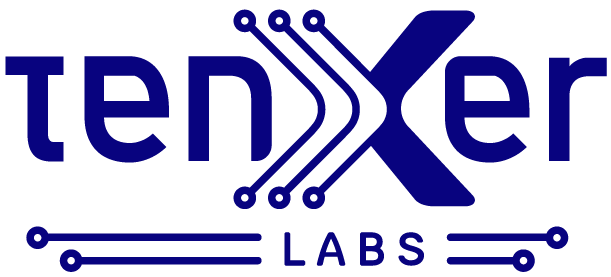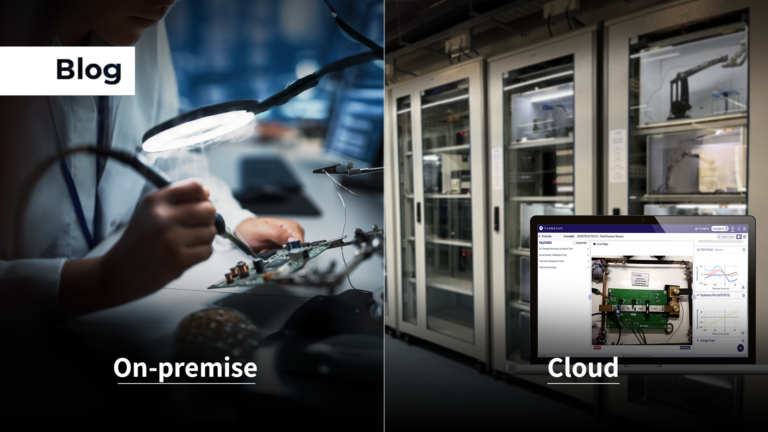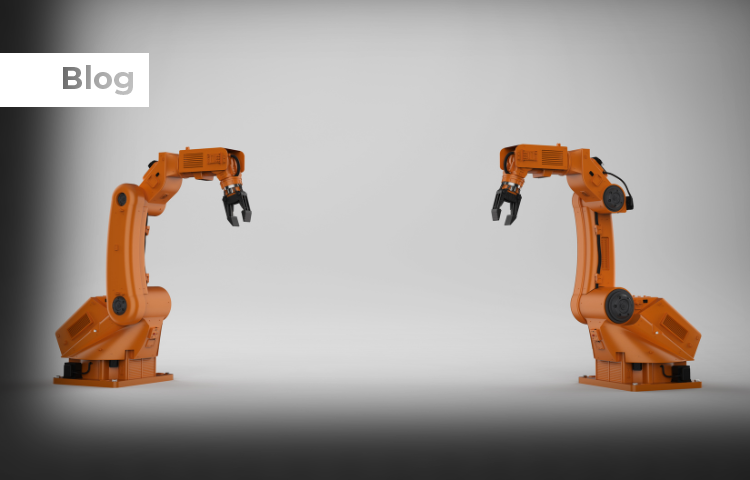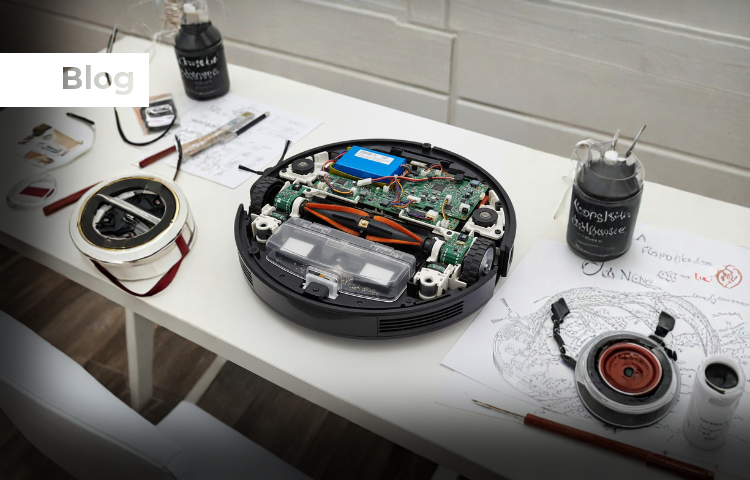Rethinking Energy Efficiency in IC Evaluation and Embedded Software Development
As industries shift towards sustainable engineering, one key area of impact is energy consumption in embedded software development. Traditional on-premise development labs require significant power, cooling, and maintenance, contributing to high CO₂ emissions.
In contrast, cloud-based evaluation platforms provide a more energy-efficient alternative, reducing power usage while enhancing engineering productivity. But how much of a difference does this actually make?
In this article, we break down the energy footprint of on-premise evaluation labs and compare it to the CO₂ savings of cloud-based evaluation.
Energy Consumption of Traditional On-Premise Labs
High Power Usage in Embedded Software Development Labs For IC Evaluation
Embedded software development labs require multiple high-power systems, including:
- Workstations & Desktops – Used for software development, debugging, and compiling code.
- Evaluation Boards & Peripherals – Constantly powered for firmware testing.
- Test Equipment – Oscilloscopes, logic analyzers, and power supplies running continuously.
❗ Average Power Consumption
A single engineer’s setup (desktop + EVK + peripherals) can consume 300–500W per hour. In a 10-person development team, this scales to 3–5 kW/hour, leading to:
15,000+ kWh/year, equivalent to 10 tons of CO₂ emissions annually.
Cooling & Infrastructure Overhead
- Air Conditioning & Climate Control – Hardware labs require cooling to maintain performance, adding 30–40% more energy usage.
- Server & Network Equipment – In on-premise setups, companies also run local servers, further increasing power draw.
❗ Impact: A fully equipped embedded development lab can use as much electricity as 10–15 homes annually.
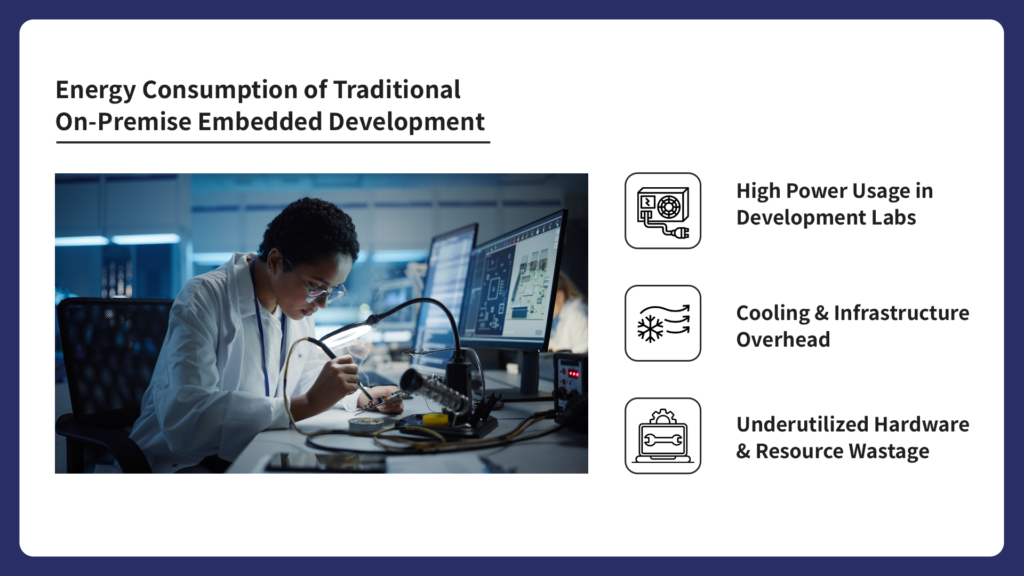
Underutilized Hardware & Resource Wastage
Most development labs run continuously, even when engineers are not actively working, leading to:
❌ Idle EVKs consuming unnecessary power
❌ Redundant hardware setups for different projects
❌ Increased e-waste from outdated lab equipment
How Cloud-Based Development and Evaluation Saves Energy
Instead of relying on energy-intensive on-premise setups, cloud solutions enable remote software development and testing on real hardware, hosted in optimized cloud environments.
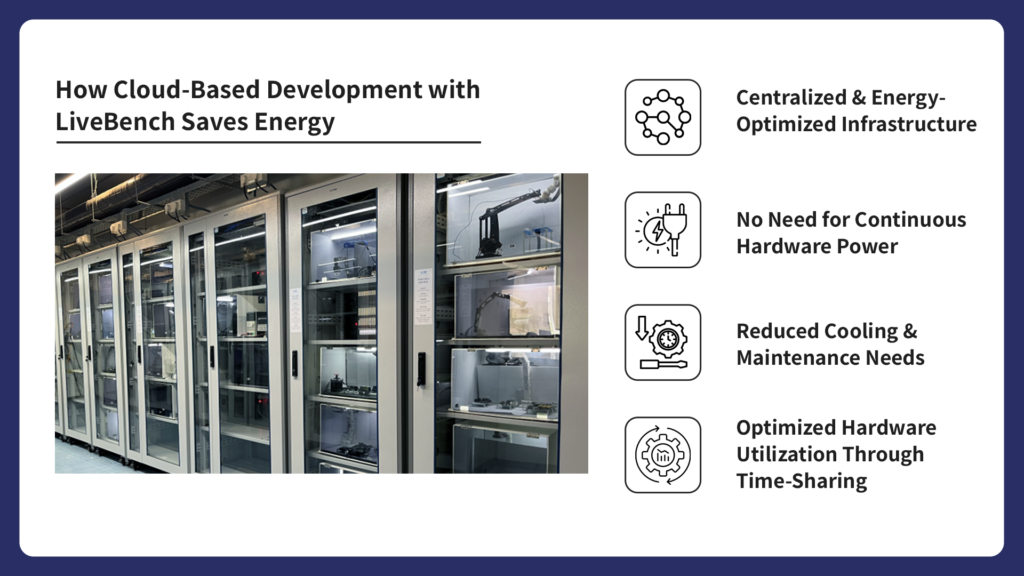
Centralized & Energy-Optimized Infrastructure
For instance, LiveBench runs on high-efficiency cloud servers designed for minimal energy waste.Unlike local workstations, cloud resources are shared dynamically, ensuring no excess power consumption.
Impact: Cloud-based development consumes 60–80% less power than maintaining a physical development lab.
No Need for Continuous Hardware Power
Traditional EVKs require constant power when connected to a workstation. With LiveBench, engineers only access hardware when needed, reducing unnecessary energy waste.
Impact: A company shifting to cloud-based development can cut 2,000–4,000 kWh per year, reducing CO₂ emissions by 2–3 tons annually.
Reduced Cooling & Maintenance Needs
Cloud data centers are optimized with advanced cooling techniques, consuming 40% less energy than individual lab setups. Companies no longer need dedicated air conditioning or power backups for on-premise labs.
Impact: Eliminating cooling overhead alone reduces total energy usage by 30%.
Optimized Hardware Utilization Through Time-Sharing
LiveBench enables multiple engineers to access the same hardware in different time slots, reducing the overall number of setups needed.
Impact: By sharing hardware resources, companies can reduce lab equipment needs by up to 50%, significantly lowering manufacturing energy costs and electronic waste, while also cutting down on cooling and maintenance power.
Quantifying the CO₂ Savings: Cloud vs. On-Premise
Let’s compare the annual carbon footprint of traditional embedded software development vs. LiveBench cloud-based development for a 10-person engineering team:
Factor | Traditional Lab (On-Premise) | LiveBench (Cloud) | CO₂ Reduction |
Workstation Power Usage | 15,000 kWh/year | 4,000 kWh/year | 73% lower |
Cooling & Infrastructure | 5,000 kWh/year | 0 kWh | 100% lower |
Hardware Utilization Efficiency | Low | High | More sustainable |
Annual CO₂ Emissions | ~10,000 kg CO₂ | ~2,000 kg CO₂ | 8,000 kg CO₂ saved |
Equivalent to… | Driving 20,000 miles | Saving 350 trees |
|
Business Benefits of Energy-Efficient SW Development on Real IC over Cloud
In addition to environmental benefits, switching to cloud-based embedded development provides:
- Faster Development Cycles – Engineers get instant access to test setups.
- Stronger Sustainability Credentials – Companies reduce their carbon footprint while meeting ESG goals.
For semiconductor makers, enabling cloud-based evaluation via LiveBench means:
- More customer engagement – Engineers can try hardware instantly, leading to higher adoption rates.
- Faster time to market – No delays in procurement, setup, or hardware availability.
- Reduced environmental impact – Supporting sustainability goals while driving innovation.
Join the Green Development Challenge and Take the Sustainability Pledge at Embedded World 2025
As part of the Sustainability Pledge, Tenxer Labs invites engineers to:
- Calculate energy savings with LiveBench
- Compare carbon footprint reduction
- Get recognition as a sustainability leader in embedded design
